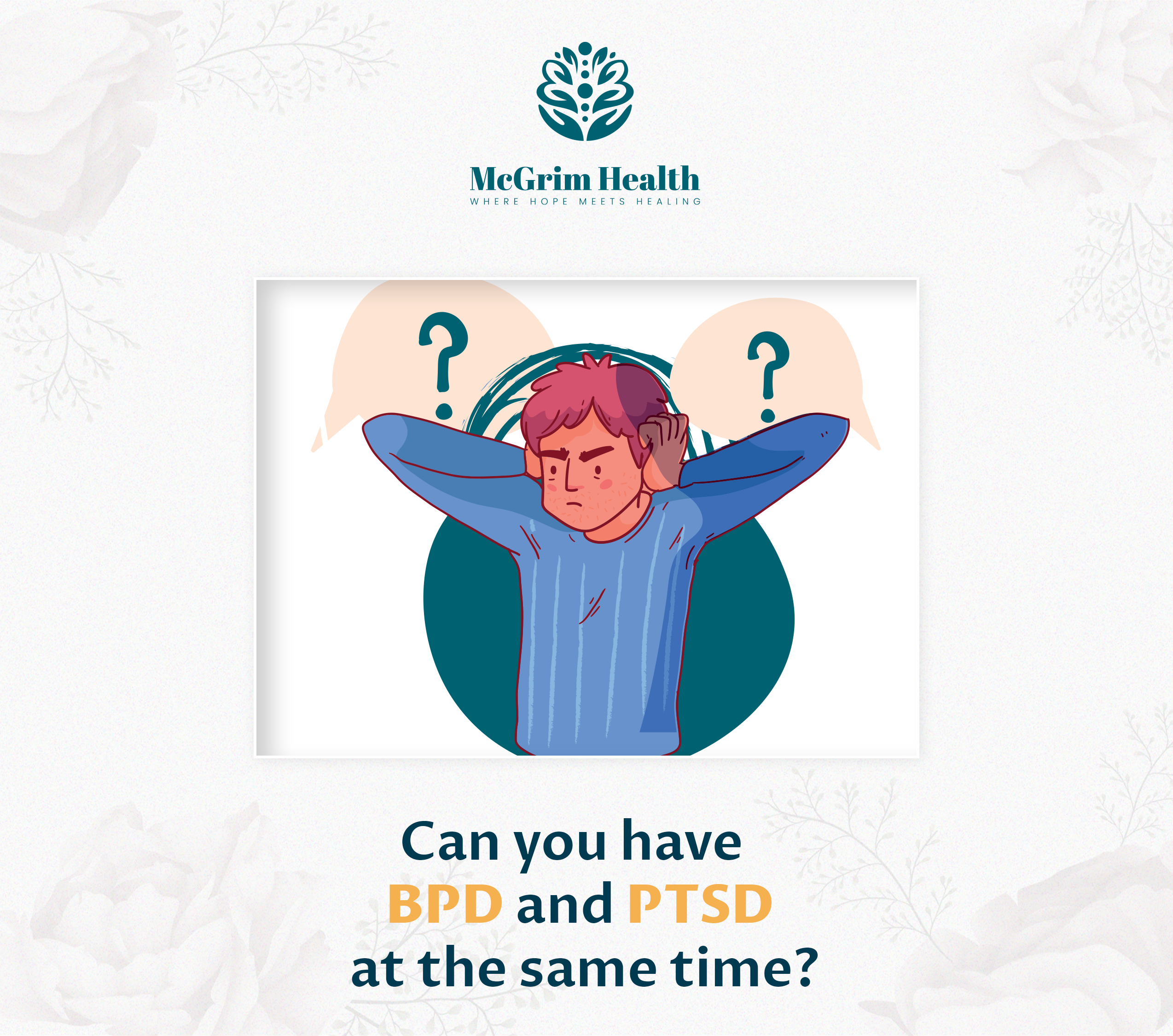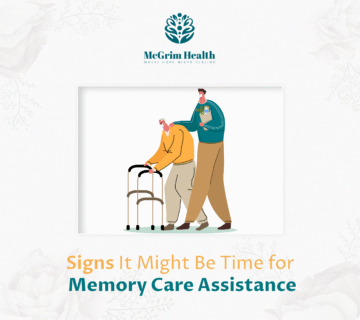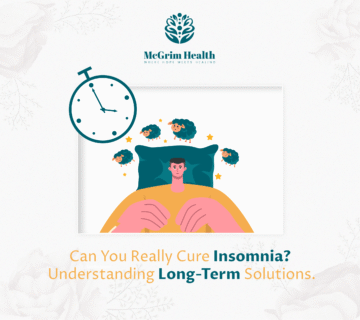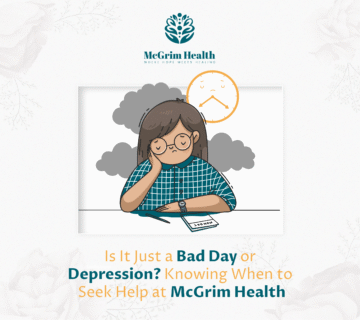Borderline Personality Disorder (BPD) and Post-Traumatic Stress Disorder (PTSD) are complicated emotional disturbances. They affect millions worldwide.
Each disorder has unique symptoms and causes. But they are connected, especially in circumstances of serious trauma. But, can you have BPD and PTSD at the same time?
Managing PTSD and BPD is a challenge. McGrim Health is here to help. Contact us for personalized support in managing these conditions.
Below, let’s delve into how these two conditions engage.
What Is Borderline Personality Disorder (BPD)?
Borderline Personality Disorder is a mental disorder. It can cause strong feelings, bad relationships, and low self-worth. BPD often means quick mood changes, being scared of losing people, and not thinking before acting. These actions can mess up normal life.
Symptoms of BPD
- Intense fear of being abandoned
- Unstable relationships, swinging between admiration and disdain
- Quick decisions, like intoxication or perilous driving
- Constant feelings of emptiness
- Difficulty managing emotions
- Self-harm or suicidal thoughts
These symptoms make daily tasks and relationships hard. They often leave people feeling alone and misunderstood.
What is Post-Traumatic Stress Disorder (PTSD)?
Trauma can deeply affect the mind, keeping some stuck in the past. They experience unwanted flashbacks and constant thoughts.
PTSD can be triggered by post-traumatic stress disorder of abandonment, adding complexity to the emotional disturbance.
Trauma alters their brains, making healing difficult. This is PTSD, a lasting effect of horrific experiences.
Symptoms of PTSD
- Visions or unwarranted worries surrounding the trauma.
- Keeping away from reminders or signs connected to the happening.
- Hyperarousal includes being easily startled and having trouble sleeping.
- It also involves emotional numbness or feeling detached from others.
PTSD sufferers relive trauma long after the event. Each person’s experience is unique, reflecting their individual history. However, all share a common struggle: a mind stuck in past years, fighting to break free.
Difference between BPD and PTSD
Causes
- BPD arises from genetics and early experiences.
- Particular distressing incidents activate PTSD.
Emotional Effects
- BPD causes extreme mood swings and difficulty regulating emotions.
- PTSD brings intense fear tied to specific memories.
Impact on Relationships
- BPD leads to instability and fear of rejection.
- PTSD results in avoidance and emotional detachment.
Focus
- BPD causes emotional instability and a fear of abandonment.
- PTSD involves anxiety and avoidance due to past trauma.
Both conditions are challenging. However, they feature varied reasons, indicators, and influences on bonds. We must understand these differences. They are key for proper diagnosis and treatment.
Is It Possible to Have BPD Without Experiencing Trauma?
Childhood trauma often causes Borderline Personality Disorder (BPD), but it’s not the only reason. Genetics, environment, and brain structure also play a role.
These factors can activate BPD without trauma. They show that BPD can develop without significant past trauma. These elements work together in a complex way, making BPD hard to explain simply.
Can You Have BPD and PTSD at the Same Time?
An individual can face both BPD and PTSD together. Many with BPD have experienced trauma, which can cause PTSD.
In clinical samples, this shows a complex link. Among those with BPD seeking treatment, 25-58% also have PTSD. Meanwhile, 10-76% of PTSD patients also have BPD.
Symptoms from both disorders can overlap. This makes it hard for clinicians to distinguish between them. Such overlap complicates accurate diagnosis and personalized treatment.
For instance, someone with BPD might have flashbacks or intrusive thoughts about past abandonment. These are also common PTSD symptoms.
BPD and Complex PTSD
What is Complex PTSD?
Frequent childhood trauma can create Complex PTSD. C-PTSD is a form of PTSD. This condition often has a more severe impact:
- Self-esteem
- Relationships
- Emotional regulation
So, can you have C-PTSD and BPD together? Yes, it’s possible to have both conditions. Knowing their distinct characteristics is key to providing effective treatment.
How is C-PTSD different from BPD?
BPD and C-PTSD cause emotional turmoil. It harms relationships.
- C-PTSD, resulting from extended trauma, leads to feelings of shame and self-doubt. In contrast, BPD brings fears of abandonment and impulsive actions.
- C-PTSD patients feel worthless. BPD patients have extreme mood swings. Both disorders disrupt lives, but they differ in causes and symptoms.
- C-PTSD leaves deep scars, while BPD is marked by impulsiveness and intense fears.
What Are the Differences in Treating BPD Vs PTSD?
PTSD and BPD share many common symptoms. However, their treatments are different. BPD is treated mainly with psychotherapy. PTSD treatment includes therapy and medications.
Psychotherapy for Both Disorders
The following treatments are in regular use:
Dialectical Behavior Therapy (DBT)
DBT transforms BPD care by imparting essential skills. Clients can control their emotions, manage stress, and improve social skills. This therapy improves life quality. It provides clarity for those with BPD.
Cognitive Behavioral Therapy (CBT)
CBT tweaks how we react to trauma. It revamps our thinking and responses. This lets individuals view their distressing experiences in a new light. Therefore, it copes with PTSD symptoms competently.
Eye Movement Desensitization and Reprocessing (EMDR)
This therapy calms those affected by PTSD or BPD. EMDR therapy reduces trauma’s impact. It helps patients reprocess painful memories, find meaning, and heal. This innovative treatment opens the path to emotional recovery.
Trauma-Focused Therapy
Trauma-based therapy grants PTSD victims a haven. They can confront and process their traumatic experiences. This promotes healing and recovery.
Medications and Alternative Treatments
Antidepressants
SSRIs effectively treat BPD and PTSD symptoms. They also target anxiety and depression. By regulating serotonin, they help manage complex emotions.
Mood Stabilizers
Prescribed for BPD, these reduce emotional swings and manage intense feelings.
Antianxiety Medications
These drugs help reduce intense emotions in BPD and PTSD patients.
Holistic Treatments
Yoga poses relieve stress. Mindfulness focuses on your thoughts. Acupuncture’s needles ease tension. These ancient methods uplift mood and energy. Moreover, holistic treatments can help manage BPD and PTSD together.
Conclusion
So, can you have BPD and PTSD at the same time? BPD and PTSD are complex mental health issues. They often occur together in people with trauma backgrounds. While they share some symptoms, their causes and impacts are different.
Getting expert care is vital for those showing BPD or PTSD symptoms. Personalized treatments and medications, guided by precise diagnoses, ensure effective management.
Professional help notably improves the quality of life for people with these complex disorders.
FAQs
Can BPD be caused by childhood trauma?
BPD is often joined to adolescent trauma, such as abuse. Abuse emotionally, physical, or sexual can deeply harm a person. Such suffering interrupts wholesome emotional progress. This can lead to BPD, a coping mechanism for intense pain.
Can someone be wrongly diagnosed with BPD?
Yes, due to symptom overlap with PTSD, anxiety, or depression, wrongly diagnosed with BPD is not uncommon.
Does EMDR work for BPD?
EMDR therapy helps with BPD symptoms related to trauma. It does this by focusing on disturbing memories, which reduces their impact and improves emotional control. As a result, many people find it easier to manage their borderline personality disorder with EMDR.





No comment